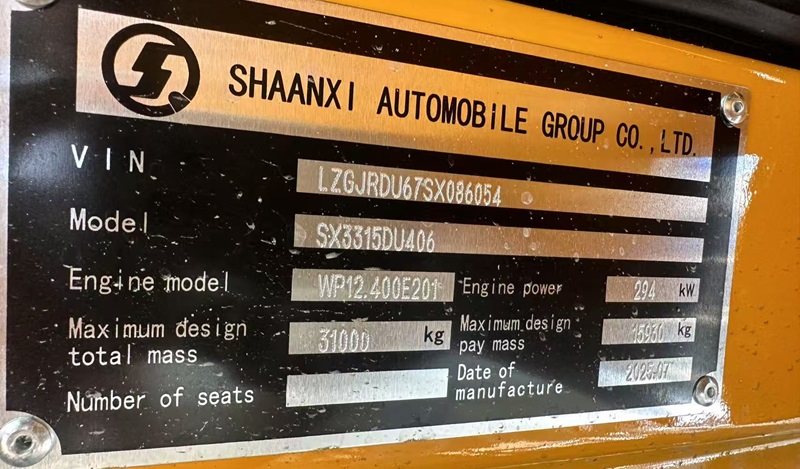When managing or operating a Shacman truck, understanding its nameplate is key to unlocking critical information about the vehicle’s identity, specifications, and compliance. Follow this guide to decode the key elements:

1. VIN (Vehicle Identification Number)
- Location: The first row, labeled “VIN”.
- Purpose: A unique 17 - digit code that serves as the truck’s “fingerprint”. It’s used for:
- Regulatory tracking: Helps authorities monitor vehicle compliance (e.g., emissions, safety standards).
- Service history: Enables dealers and repair shops to access maintenance records.
Insurance & ownership: Simplifies claims and title transfers.
2. Model
- Location: The second row, labeled “Model”.
- Purpose: Identifies the truck’s model (e.g., SX3315DU406). This code:
Defines the truck’s design (e.g., cab style, chassis configuration).
Helps locate spare parts, service manuals, and technical bulletins.
3. Engine Model & Power
- Engine Model: The third row, labeled “Engine model” (e.g., WP12.400E201). Indicates the engine’s make, displacement, and key specifications (e.g., “WP” denotes Weichai Power, a common engine supplier for Shaanxi trucks).
- Engine Power: The adjacent column, labeled “Engine power” (e.g., 294 kW).
Shows the engine’s power output, which influences the truck’s hauling capacity and performance
4. Mass Specifications
- Maximum Design Total Mass: The fourth row, labeled “Maximum design total mass” (e.g., 31000 kg).
- The truck’s maximum allowable weight (including the vehicle, driver, passengers, and cargo).
- Maximum Design Pay Mass: The adjacent column, labeled “Maximum design pay mass” (e.g., 15950 kg).
- The maximum weight of cargo the truck can carry (calculated as Total Mass - Unladen Mass).
5. Number of Seats
- Location: The fifth row, labeled “Number of seats”.
- Indicates how many people the truck’s cab can safely accommodate, impacting driver fatigue regulations and vehicle classification.
6. Date of Manufacture
- Location: The last row, labeled “Date of manufacture” (e.g., 2025.07).
- Records when the truck was built, which: Affects warranty coverage.
- Helps track technological updates and regulatory changes over time.
Why This Matters
Understanding the nameplate ensures you:
- Comply with regulations: Know the truck’s weight limits, emissions standards, and safety requirements.
- Optimize operations: Match the truck’s capacity to your hauling needs (e.g., don’t overload beyond Maximum Pay Mass).
- Simplify maintenance: Use the VIN and model to order parts and schedule service efficiently.
By mastering these nameplate elements, you’ll have a clear, actionable understanding of your Shacman truck’s capabilities and compliance requirements.